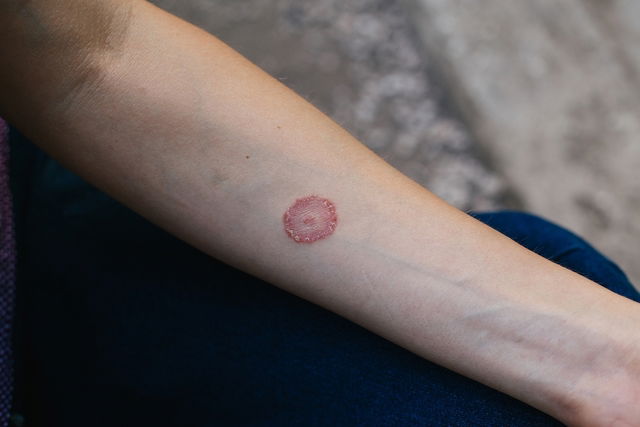Ringworm, also know as dermatophytosis or tinea, is a fungal infection of the skin caused by dermatophytes. Dermatophytes are a type of fungi that have a strong affinity to skin's keratin, and therefore these fungal cells are most found in areas with higher concentrations of keratin, like the skin, hair, or nails.
Ringworm transmission usually occurs through direct contact with contaminated animals, people, objects or soil, but it can also happen through inhalation of keratin fragments that may be suspended in the air.
This type of infection is more common in people whose occupation encourages direct contact with fungi, such as farmers or athletes, but it is also frequent in people with health conditions that favor fungal development, such as diabetes.

Main causes and symptoms
The causes and symptoms of ringworm can vary according to the type of fungal infection:
1. Athlete's foot
Athlete's foot, also known as tinea pedis, is a type of ringworm that affects the feet. It is a common condition in athletes, as they tend to wear closed shoes with sweaty socks for longer, which promotes the growth of fungus.
The main symptoms of athlete's foot include itchiness in between the toes, flaky skin and whitening in the area, as well as foul odor.
2. Tinea capitis
Tinea capitis is a type of ringworm that affects the scalp and it can be caused by Trichophyton tonsurans or Trichophyton schoenleinii fungi. Each of these types cause different symptoms.
Trichophyton tonsurans is characterized by the appearance of small dry plaques of alopecia, or areas with no hair growth. Trichophyton schoenleinii may cause the development of big white plaques on the head, similar to dry crusts.
3. Jock itch
Jock itch, also known as tinea cruris, is a type of ringworm that affects the groin area, inner thighs and buttocks. This type can also affect other hairless areas of the body.
Signs and symptoms of jock itch normally includes itchiness, redness and skin irritation.
4. Tinea corporis
Tinea corporis is the ringworm of the body that can cause characteristic pink patches with a red border, itchiness and sometimes flaky skin.
5. Onychia
Onychia is a type of ringworm that affects the nails and it usually causes changes to the coloring, shape, and thickness of the nails.
How is ringworm diagnosed
Ringworm diagnosis is confirmed via both assessment of the affected area by the doctor and laboratory tests. Visual assessment of the affected skin is not sufficient on its own to confirm ta diagnosis, since many signs and symptoms can be confused with other skin diseases. Therefore, doctors will typically collect samples of any suspicious areas (skin, hair, and nails) to be analyzed microscopically.
The classic diagnosis of dermatophytosis happens with two tests: the first is a direct test, in which the samples are observed in a microscope as soon as they arrive at the laboratory. The second is a culture test, in which the collected sample is placed in a suitable environment so that fungi can grow, confirming the diagnosis.
Another complementary test that can be carried out is a Wood's lamp exam, in which a UV light is applied to the affected region in order to verify if fluorescence happens. This is because some fungi react to the presence of UV light, allowing them to be identified more easily.
Treatment options
In most cases, ringworm is treated with topical medication. The doctor may prescribe an antifungal lotion or cream like clotrimazole or miconazole. In cases of more extensive, spreading lesions or in the case of nail or scalp ringworm, oral antifungal medication may also be necessary.
The best oral medication to treat ringworm are terbinafine and griseofulvin, both of which should only be used under doctor prescription. Griseofulvin should not be used to treat ringworm in children.
Home treatment
There are some plants that can help treat ringworm and relieve itchiness, as they contain antifungal and healing properties. These include sage, cassava, aloe vera, and tea-tree.
